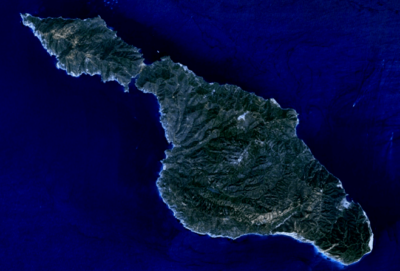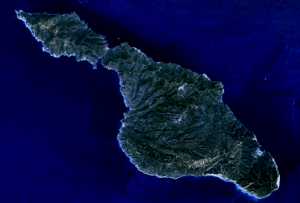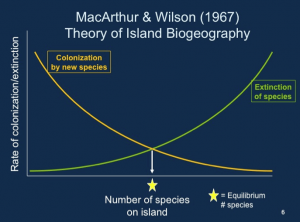
What is biogeography?
It’s the study of which, and how many, species live where, and why! Biogeography is the study of biodiversity – the variety of life on Earth – and how it is distributed. Why are the North-facing slopes on Catalina greener than their south-facing counterparts? (Hint: it’s because of sunlight and rainfall patterns). Why are there some 61 endemic species here on Catalina that live only here and nowhere else in the world? (Hint: it’s because of the isolation of the island). Why are some of them only found in one particular canyon or grove? (Hint: it’s because of niches). How do invasions and extinctions affect the island? (Hint: it’s all about balance). And how can we apply all this to the bigger picture of life on Earth? (Hint: the answers are all here, in miniature!) Digging deeper into these questions is what biogeography is all about.
 Satellite imagery of Catalina island, showing topographical features and vegetation patterns. Image credit: Google Earth
Satellite imagery of Catalina island, showing topographical features and vegetation patterns. Image credit: Google Earth
Science paradise
Islands generally have fewer species, and therefore fewer relationships between them, which makes them an excellent place to study ecosystem dynamics in a simplified environment: what science writer David Quammen calls a “caricature of nature’s full complexity” in his book Song of the Dodo: Island Biogeography in the Age of Extinctions. Island biogeography is especially interesting because an island is like a petri dish to study the diversity of life on continents, in oceans, and across our planet.
 MacArthur and Wilson coined the term “Island Biogeography” in their 1967 study that aimed to characterize the biodiversity of a given island by looking at the equilibrium reached between colonization (new species arriving) and extinction (species dying out completely). Image credit: californiachannelislands.blogspot.com
MacArthur and Wilson coined the term “Island Biogeography” in their 1967 study that aimed to characterize the biodiversity of a given island by looking at the equilibrium reached between colonization (new species arriving) and extinction (species dying out completely). Image credit: californiachannelislands.blogspot.com
Find your niche!
Life can survive anywhere there are resources: these include a source of energy (like the sun for a plant, plants for an herbivore, animals for a carnivore, or decomposing material for a detritovore); a form of protection from predators and elements (a cliffside, a seashell, or a patch of trees); and a way to replenish their population with young that are genetically diverse (currents that carry eggs; bees that pollinate; or wind that brings new seeds). Once species arrive to an area, they look for all those resources in a special niche – in ecology, that’s the word for the perfect set of conditions under which a species can thrive. Sometimes, a species becomes so adapted to its specific niche that it becomes unlike other members of its species and begins to form its own group. On islands, this phenomenon is common. One example is the Catalina Island Fox, that underwent island dwarfism, and is much smaller and scragglier (with about 25% less body mass) than its big cousin, the Gray Fox, due to scarce island food resources.
 A gray fox skull compared with the skull of an island fox, a dwarf subspecies. Image credit: OseteologicalsRock, Wikimedia Commons.
A gray fox skull compared with the skull of an island fox, a dwarf subspecies. Image credit: OseteologicalsRock, Wikimedia Commons.
The biogeographer’s tools
Biogeography is all about looking for patterns. So, any method that maps larger patterns of resources, like water chemistry sampling, satellite imagery, remote sensing, animal tracking and tagging, and vegetation surveys, for example, can tell us more about the biogeography of the island. Genetic testing can tell us more about the divergence and diversity of species, as well. You can do a little biogeography wherever you live, too! Just get a little perspective – climb up, paddle out, or just get down on your belly in a patch of grass – and notice who is living where!
To learn more:
Play the demo of this game about ecological niches and genetics in development, and try to survive!
Check out some satellite data on chlorofyll and sea surface temperature around the channel islands (you will need Java installed)
Check out the American Museum of Natural History’s Center for Biodiversity
Check out David Quammen’s book on island biogeography
Check out the Catalina Island Conservancy’s list of endemic species


